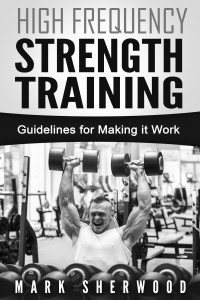Training frequency refers to how often a lifter trains each body part during a week. If you are already familiar with Precision Point Training, you know that I tend towards a preference for high frequency training where each body part is trained at least three times per week, and up to five times per week. I have even trained each body part six times per week. Having said that, I need to stress that I believe that the effectiveness of high frequency training is not something that automatically works under all training conditions. The effectiveness of high frequency training is based on two very important aspects of training. The first condition is that a lifter does not exceed their marker rep where rep speed slows down during a set. The second condition is that they only continue to do sets for a body part as long as that body part is at full strength. This means a lifter should quit training a body part at the point where they begin to weaken. I could also add a third condition, which is to not do more than 15 reps during a set. Under these conditions, I believe that high frequency training is effective. If you insist on doing lots of sets and fatiguing your muscles by pushing past the point where rep speed begins to slow down, then I do not have much confidence that using a high training frequency will work.
Low Frequency Lifters
Even though I myself benefit more from high frequency training than low frequency training, I can’t say this is true for everyone. There are people have found success by training a body part only once per week. One of the first people that comes to mind in reference to training each body part only once per week is Kirk Karowski. If I’m not mistaken, he is a 1,000 pound squatter. There’s no doubt that his methodology worked for him. Another is Mark Chaillet who was able to bench 520, squat 960, and dead lift 880 pounds. One training session per week undeniably works for these lifters.
Different Exercises May Respond Best to Different Training Frequencies
In discussing training frequency, what I really want to focus on is that you may find that different exercises benefit most from different amounts of training each week. The only exercise that ever gave me positive results when doing it only once per week was the squat. A lot of lifters prefer squatting only once per week, and many find that deadlift training works better with low frequency training as well. At the same time, it is not uncommon for these same lifters to train their upper body twice or more per week. Fred Hatfield (one of the earliest lifters to squat over 1,000 pounds) advocates using different training frequencies for different body parts. According to his philosophy, the bigger the muscle group, the less often it needs to be trained, and the smaller the body part, the more often it can be trained. You can find examples of his preferred training frequencies for various body parts by clicking here to go to Fred’s website. Also Books by Fred Hatfield
Fred’s 1,000 pound squat
Training Frequency for Those who are Involved in Sports
Another important thing to consider is that the great majority of sports emphasize much more involvement from the legs than the upper body. The reason I bring this up is because some of you may be involved with weight training in order to help you improve your performance in a sport that you are involved in. I know the reason I began weight training was to help me improve at pole vaulting in high school, and also to help me with basketball. If you are involved in sports, then your legs may already be receiving a substantial workout from playing the sport that you are involved in, and it may be more beneficial to cut back on the number of days that you work your legs than to use a higher training frequency.
These are all things to consider when determining your workout frequency. Even though there was a time period when I made progress by squatting once per week, and I still play basketball which gives my legs an additional workload to deal with, I still prefer high frequency squats that don’t fatigue my legs during a workout as opposed to blasting my legs once or twice per week. However, each person must listen to their own body and let results speak for themselves when choosing the best training frequency for their own body. Don’t be afraid to experiment in order to find out what works best by trying different training frequencies for different exercises, and don’t be afraid to change your training frequency during a sports season if you are involved in sports. Best of training to you.

